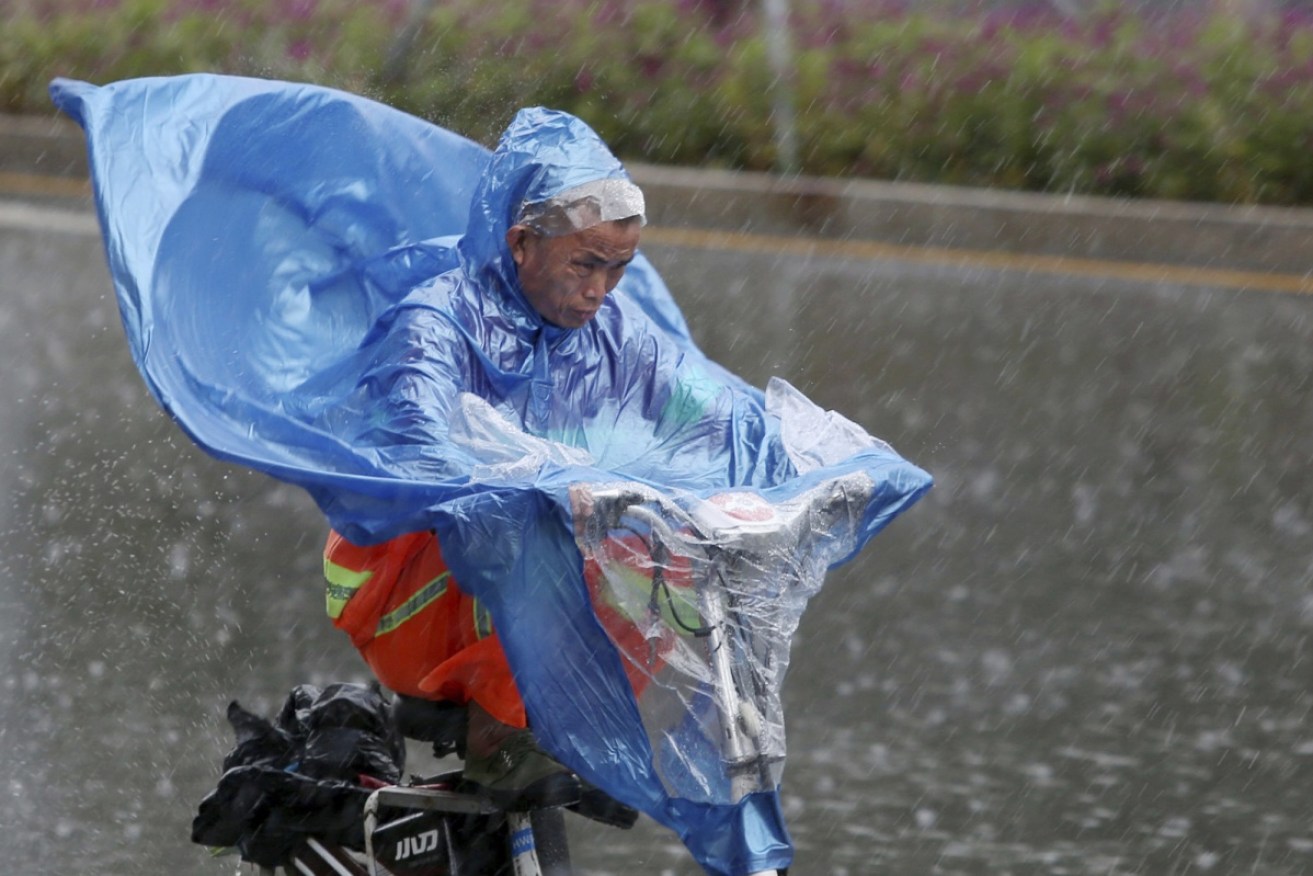Death toll from Typhoon Manghkut rises as it wreaks havoc across southern China


A cyclist braves the storm in Shenzhen, in China's Guangdong province. Photo: AAP
Super storm Mangkhut was cutting a terrifying path across southern China on Monday, after lashing the Philippines with heavy rain and strong winds that left at least 100 people dead.
The storm – the strongest of the year and the biggest to hit Hong Kong in nearly two decades – had already killed at least two people in China’s Guangdong province on Monday.
In Guangdong, more than 2.4 million people were evacuated in and 50,000 fishing boats called back to port.
#typhoon #manghkut on #HK already 12 hours & still no sign to leave.#MyHome #update:
2 windows flood water in.
TV lost signal – 1st time ever!
Ceiling lights keep flashing on/off~😱
We've #typhoons every year but never had this before!😰
Video from web#台风山竹 #TyphoonMangkhut pic.twitter.com/E0kgV8SsRW— Helen L.H. Wong (@helenwonglh) September 16, 2018
News Corp reported that China’s three southern provinces of Guangdong, Guangxi and Hainan were co-ordinating preparations for the typhoon, including suspending transport and moving people to shelter inland. The area is home to a string of megacities and more than 100 million people.
There are fears Mangkhut could affect two nuclear power plants on its projected path. Emergency officials were on standby at the Taishan Nuclear Power Plant and Yangjiang Nuclear Power Station, both in Guangdong.
“All emergency personnel are at their posts and have conducted their preparatory work,” officials said in a statement.
The storm has also fuelled concern about sugar production in Guangdong, which accounts for a tenth of national output, at about one million tonnes. China sugar futures rose last week on fears for the cane crop.
Trees felled by strong winds as #TyphoonMangkhut batters southern China pic.twitter.com/KRj48aIhpF
— China Xinhua News (@XHNews) September 17, 2018
High winds and swells have also hit Fujian province north of Guangdong, shutting ports, suspending ferry services and cancelling more than 100 flights. Waves as high as 7.3 metres were seen in the Taiwan Strait, state news agency Xinhua said.
On the northern Philippines island of Luzon Island, where the super storm hit on Saturday, it had sustained winds of 205km/h and gusts of 255km/h.
Landslides accounted for most of the fatalities in the Philippines. Dozens more people remain missing, feared dead, including at least 40 gold miners who were trapped in a bunkhouse buried in a landslide near the town of Itogon.
Local mayor Victorio Palangdan said up to 50 people were thought to be inside the bunkhouse when the landslide occurred. Another 32 people had been reported dead in separate incidents in Itogon, he added.
“I can’t begin to accept this, but it looks like the casualties here are going to go up to at least 100.”
With many bus lines out of service in the aftermath of #TyphoonMangkhut, the Tai Wai MTR station is a mosh pit of people this morning. pic.twitter.com/O2ndXpCeMC
— Mary Hui (@maryhui) September 17, 2018
Mangkhut is thought to be the strongest storm to hit Hong Kong since Typhoon York in 1999. Its top-of-the-scale Category 5 winds are about twice the speed of the gusts generated by Hurricane Florence in the US.
Videos posted online from Hong Kong – where Mangkhut hit on Sunday – showed the corner of a building breaking, and tall buildings swaying. Windows on commercial towers were shattered, sending paper pouring out of buildings and glass plunging to the ground.
The storm also brought down trees, tore bamboo scaffolding off buildings and left some areas of Hong Kong flooded to waist-level, according to The South China Morning Post.
On Monday, emergency workers in began clearing trees that had fallen across major roads as terrifying videos showing the super typhoon’s destructive power emerged.
Frightening footage shows fierce winds that reached 270km/h breaking down the doors of an international hotel, while other video shows gigantic waves beating against high rises and a crane at the top of a high rise being toppled.
All flights out of Hong Kong were cancelled overnight on Sunday.
Shenzhen also cancelled all flights and the cities of Haikou, Sanya, Guangzhou, Shenzhen and Zhuhai were also affected.
Rail services in Guangdong and Hainan provinces were also halted.
-with agencies







